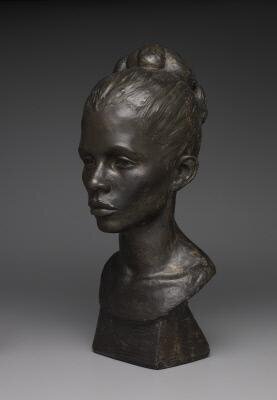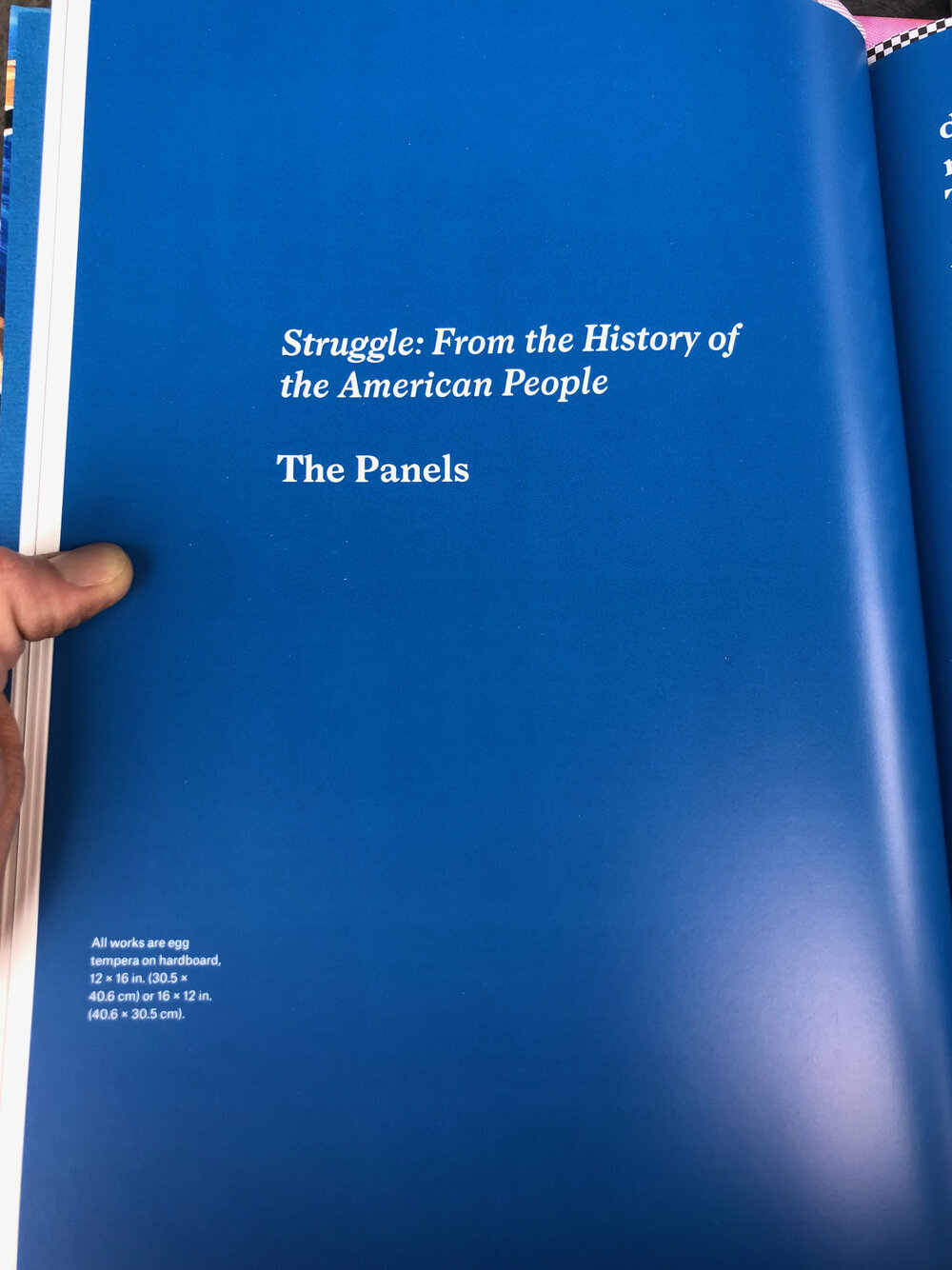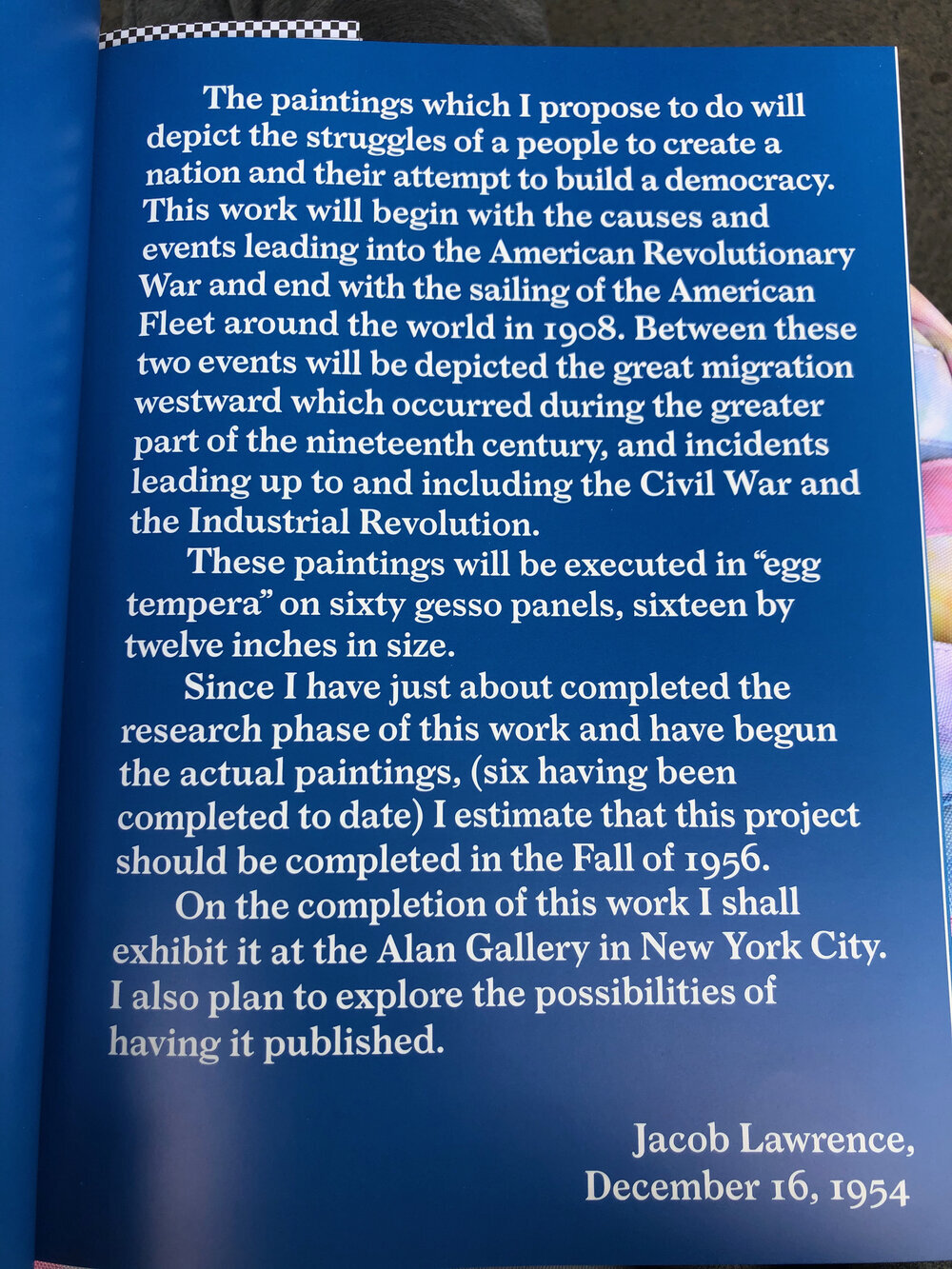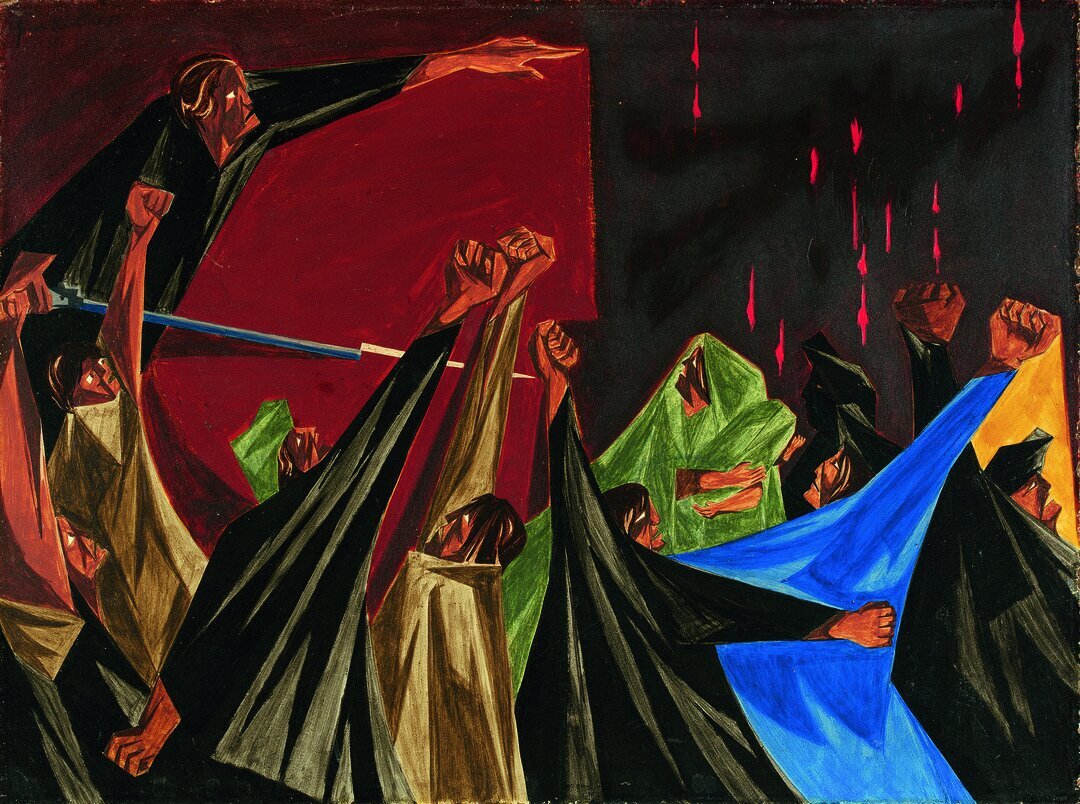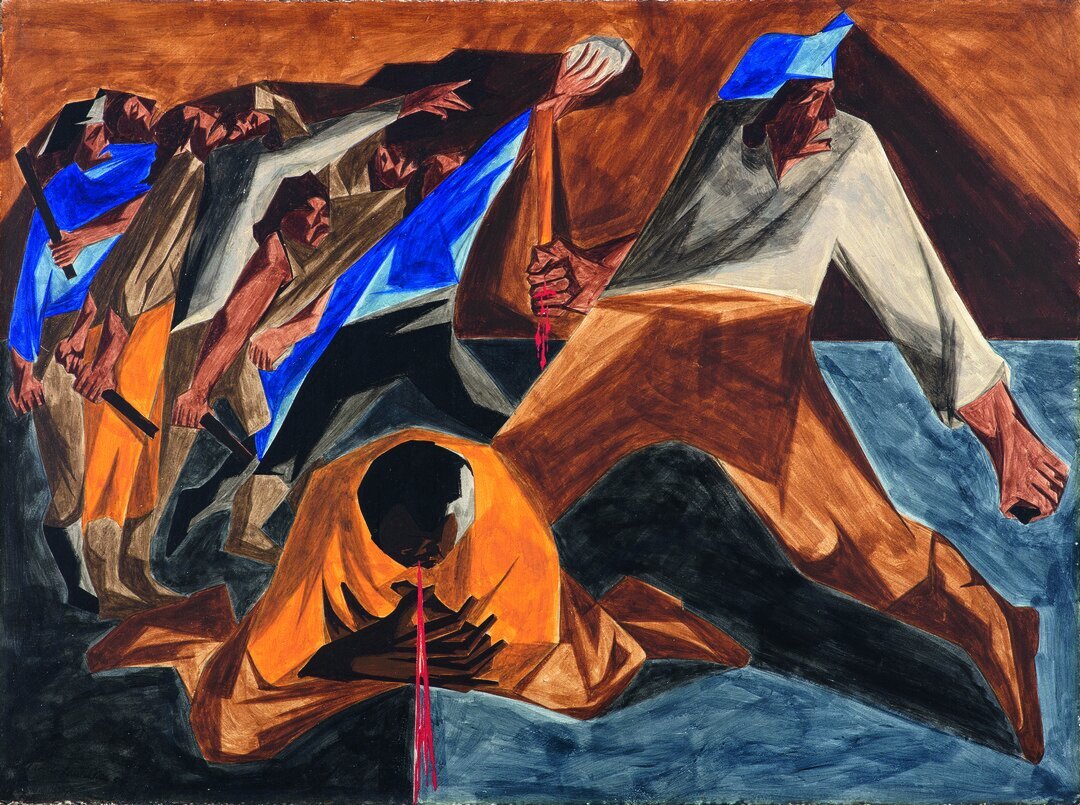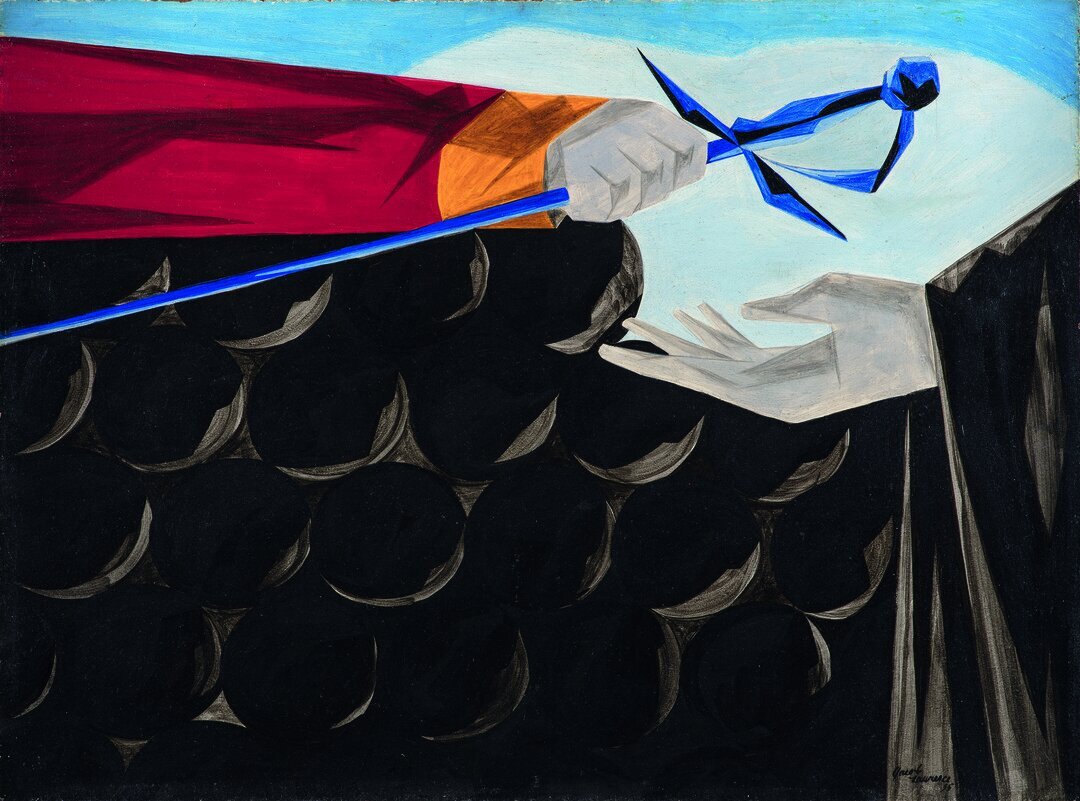JACOB LAWRENCE: THE AMERICAN STRUGGLE
Last Fall I fell in love with a poem by Marilyn Nelson called Hitting Bottom. It articulates the despair Harlem sculptor Augusta Savage must have felt at the loss of her husband and newborn baby in 1924. This hopelessness gave voice to some of what I had felt at the time, stuck between a pandemic, police riots, and raging wildfires. Hope seemed if not lost, at least not visible through the plumes of smoke and teargas. “What is the point of making art,” the poem asks. “Flowers on graves? Dancing in masks to placate death?” All artists arrive at this question sooner or later. And the answer must be convincing, compelling, literally moving. Otherwise why go on?
image capture via poetryfoundation.org
Augusta Savage did carry on, and in 1935 she exhibited a plaster portrait of her student Gwendolyn Knight that is now in the permanent collection of the Seattle Art Museum. That same year Knight met a young man working alongside her on a Works Progress Administration (WPA) mural. His name was Jacob Lawrence and they would spend the remaining decades of their lives together in Harlem, Seattle, and beyond. Lawrence, seated next to Gwendolyn in a 90’s era interview spoke highly of Savage. “She was a mentor to many of us in the Harlem community,” he says, “and she liked us, the young people. She worked with the young people and took an interest in us. And I was one of those fortunate enough to have her take an interest in me.”
With historical perspective it is easy to see that Savage must have continued making art. But what if she hadn’t? The timeline we are in, the one we call reality, is just one possible world of many. The fact that Augusta Savage carried on, mentored young black artists, persisted in finding them lucrative work for the Federal Art Project changed the trajectory of Art and History, alike. It’s a revelation that preordains the most haunting takeaway of the current Jacob Lawrence exhibit: that our entire lives could have been very different. The frailty of existence is exposed.
Gwendolyn Knight, Painted plaster, 18 1/2 x 8 1/2 x 9 in., by Augusta Savage. image via seattleartmuseum.org
In 1949 Lawrence embarked on a research project aimed at representing the struggles and contributions of Black Americans across history. By 1954 he had reframed his goal, writing that “it seems that this project has ceased to be the story of the Negro people in America and become the story of the American people. . . [and] will depict the struggles of a people to create a nation and their attempts to build a democracy.” To tell the story of Black Achievement is, inevitably, to tell the story of America. The culmination of this project would be, as Lawrence wrote in December 1954, the completion of sixty paintings, each egg tempera on panel measuring sixteen by twelve inches. He completed 30 and nearly all of those are currently on view at the Seattle Art Museum.
Jacob Lawrence: The American Struggle, Peabody Essex Museum and University of Washington Press, edited by Elizabeth Hutton Turner and Austen Barron Bailly, 2020.
Buy your copy of the catalog here.
The series of paintings, as well as the exhibition, is titled The American Struggle. It is a research-oriented historical re-examination of many of the myths foundational to America, particularly White America. The paintings bring history into reality in a way that makes one thing clear: the future was never pre-ordained. “Lawrence gets at a different kind of truth,” writes Jasmyne Keimig about the exhibition. “America’s persistence as a country and a project was not foretold. Rather, it was violently taken and sketched out, marked by slavery, genocide, war, and immense struggle experienced by those seeking their own freedom and those looking to impose their will on others.”
Nearly as often as blood is seen splattering across the 30 paintings, Lawrence depicts tools. Swords, hammers, swords, bayonets, a rake, shovel, wheelbarrow, horse reigns, more swords. Lawrence was long enamored with tools as a symbol of uplift, building, and achievement. “Instead of words or other symbols, I use paint,” he said. “Everything I have to say is in my paintings.”
. . . is life so dear or peace so sweet as to be purchased at the price of chains and slavery? —Patrick Henry, 1775, Panel 1, 1955
In the first panel of the series we see Patrick Henry delivering his mythical 1775 speech to the second Virginia Convention, from which we received the now-worn-out slogan “Give Me Liberty or Give Me Death!” Elsewhere in his speech he asks “. . . is life so dear or peace so sweet as to be purchased at the price of chains and slavery?” It’s a rhetorical question. The answer is no. But that’s not the answer history gave us. The attendees are furious looking. Elizabeth Hutton Turner writes that “Lawrence emphasizes not the speaker but the impact of the speech.” Steve Locke points out that “The intersection of angles creates points of tension and release, like eddies. The fists are the crests of these waves, points of resolve.” With this panel Lawrence asks us to wonder “what if?” What if the signers of the declaration had been uncompromising in their idealism? What if American Independence had insisted from the outset on the freedom of all people? What if American Independence had not been purchased at the price of chains and slavery?
Massacre in Boston, Panel 2, 1954
The second panel, Massacre in Boston, is centered around a kneeling figure, bleeding and clutching his chest. The man is Crispus Attucks, a ‘seamen of Indigenous and African descent’ who is widely regarded as the first casualty of the American Revolution. In the painting’s presence I was struck by the sense that Crispus seemed to be time-traveling, like he had been telegraphed from a future in which those still struggling for freedom echo chants of “I Can’t Breathe” across this land. Like he is being asphyxiated by the weight of everything that followed his death— an Independent America that upheld slavery for another 80 years and which followed that with a brutal civil war, Jim Crow, the KKK, and Mass Incarceration. Certainly Crispus Attucks had envisioned a different future for his country and for his people as he lay dying of British gunfire. Spencer Crew writes that “His sacrifice embodies the irony of life for African Americans throughout the history of the nation. . . The freedom demanded by others in the group did not truly include him.”
Victory and Defeat, Panel 13, 1955
If the death of Attucks is the beginning of the American Revolution, the 22 day siege of Yorktown is the conclusion. In panel 13, Victory and Defeat, Lawrence has depicted the symbolic sword surrender ceremony between American General George Washington and British General Charles Cornwallis. The trouble is, this scene is entirely fictive. Cornwallis, the loser, refused to participate in the peaceful transfer of power. In his composition, Lawrence has reduced this episode of American history to only its most essential elements. 22 cannonballs for the 22 days, a pale redcoated hand relinquishing a blue sword to another pale hand. It’s all here. The whiteness. The violence. The hope of a new nation, present in the vivid blue sky revealed as the clouds lift.
Peace, Panel 26, 1956
In Panel 26, Peace, we see a barren brown hillside foregrounded by a row of sorrowful looking flowers. The title refers to the treaty of Ghent, which had ended another war with the British. The feeble flowers remind us of the steep price of peace as well as its continued precarity. It must not be forgotten that Jacob Lawrence was painting this series at the height of the American Civil Rights struggle. It is a similar moment we find ourself in today, society being upheaved as we struggle for Racial Justice and Equality. Andrea Douglas brings this point home for us in the catalog:
“In 1956, when the work was created, the Montgomery bus boycott was in full swing with escalating violence that included the bombing of Martin Luther King Jr.’s home. American identity was fracturing along lines of its most basic civil rights and the protest’s end was still an entire year away. Yet there is hope in Lawrence’s canvas. His emaciated flowers strain upward toward a nourishing sky to suggest that peace, which today seems so elusive, is indeed attainable and fulfilling.”
Jacob Lawrence: The American Struggle is on view through May 23rd at the Seattle Art Museum. In June the exhibition travels to The Phillips Collection, Washington D.C. where it will be on view from June 26-September 19. Go check it out!


